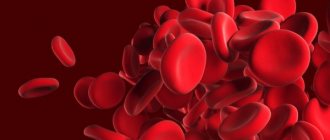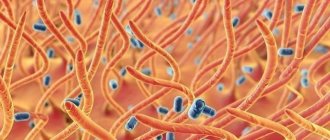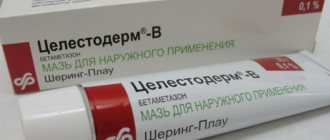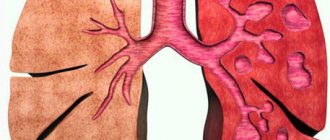RADIATION SICKNESS develops as a result of exposure to decomposition. types of ionizing radiation (IR). Sources of radiation are often alpha, beta and gamma radiation, neutron or proton fluxes, and x-rays. L. b. can cause external or internal. irradiation. In the second case, radioactive substances enter the body through the respiratory tract, gastrointestinal tract, skin and mucous membranes, as well as through intravascular or intracavitary administration. AI causes the ionization of atoms and molecules and affects the internal. cell structures, including mitochondria, lysosomes, chromosomes and DNA strands. As a result, cell death or serious disruption of their functions may occur. The most sensitive to IS are rapidly dividing cells - bone marrow, intestines, skin, mucous membranes, and gonads.
Causes
Irradiation of the body can occur as a result of massive exposure to significant doses of penetrating radiation during man-made disasters, nuclear weapons testing, failure to comply with safety precautions during professional work involving radiation, as well as during radiotherapy.
Systematic irradiation of the body with γ-waves, neutrons or X-rays is possible for medical personnel in radiation therapy and diagnostic departments, and for employees of industrial enterprises in contact with sources of radioactive radiation.
Radioactive compounds can enter the body through the digestive tract (with water or food), the respiratory system, damaged skin or mucous membranes, as a result of injection, or injury.
Doses of dangerous radiation exposure
To prevent the occurrence of consequences that result from radiation, it is necessary to constantly monitor the background radiation and its level at work, in residential premises, in food and water. In order to assess the degree of possible damage to living organisms and the impact of radiation exposure on people, the following quantities are used:
- exposure dose. Exposure to ionizing gamma and x-ray radiation in the air. It has the designation kl/kg (pendant divided by kilogram);
- absorbed dose. The degree of influence of radiation on the physical and chemical properties of a substance. The value is expressed in a unit of measurement - gray (Gy). In this case, 1 C/kg = 3876 R;
- equivalent, biological dose. The penetrating effect on living organisms is measured in sieverts (Sv). 1 Sv = 100 rem = 100 R, 1 rem = 0.01 Sv;
- effective dose. The level of radiation damage, taking into account radiosensitivity, is determined using sievert (Sv) or rem (rem);
- group dose. Collective, total unit in Sv, rem.
Using these conditional indicators, you can easily determine the level and degree of danger to human health and life, select the appropriate treatment for radiation exposure and restore the functions of the body affected by radiation.
Forms
Depending on the time of injury and the total dose of absorbed radiation, radiation sickness occurs:
- acute – develops with a single intense exposure to radioactive radiation. The total dose of absorbed radiation exceeds 1 J/kg (100 rad);
- chronic – formed during prolonged exposure to relatively small (0.02 Gy/min or less) doses.
Depending on the absorbed dose, acute radiation sickness is divided into several clinical forms:
- radiation injury – absorbed dose is less than 1 Gy;
- bone marrow form – 1–6 Gy, typical form;
- transitional form – 6–10 Gy;
- intestinal form – 10–20 Gy, occurs with severe enteritis, fever, bleeding from the gastrointestinal tract;
- Toxemic (vascular) – 20–80 Gy, characterized by hemodynamic disturbances;
- cerebral form – over 80 Gy, accompanied by cerebral edema.
A total annual dose of 1–3 mGy is considered safe for health.
The bone marrow form has 4 degrees of severity depending on the absorbed dose of radiation:
- mild degree of radiation sickness (1–2 Gy);
- moderate (2–4 Gy);
- severe (4–6 Gy);
- extremely severe (more than 6 Gy).
Depending on the routes of exposure to radioactive substances, the following options for the development of chronic radiation sickness are possible:
- chronic radiation sickness, provoked by general radiation (in case of exposure to general external radiation or radioactive isotopes with their uniform distribution in the body);
- chronic radiation sickness caused by the ingestion of radioactive isotopes into the body through selective deposition or local irradiation.
Classification of the disease
In modern medicine, types of radiation sickness are distinguished by time and nature of localization.
Depending on the irradiation time, the following forms are distinguished:
- one-time;
- prolonged;
- chronic.
By the nature of localization:
- local or general form;
- uniform or uneven.
As medical practice shows, the acute stage of the disease is accompanied by damage in all areas of the skin and at all levels - tissue, molecular, organ. Cerebral edema is almost always observed. If the patient is not provided with the correct treatment, then death is possible.
Stages
The course of a typical (bone marrow) form of acute radiation sickness goes through 4 phases.
- The phase of primary general reactivity develops immediately after radiation exposure. Duration from several hours to several days.
- The latent phase is imaginary clinical well-being. Duration from 3-4 days to 4-5 weeks.
- The phase of developed symptoms. In case of recovery, it lasts 2–3 weeks.
- Recovery. Duration from 6 months to 3 years.
Chronic radiation sickness, caused by general exposure, goes through three stages in its development:
- Formation stage. Lasts 1–3 years. A clinical syndrome develops.
- Recovery. It begins 1-3 years after the cessation or reduction in the intensity of radiation exposure.
- Stage of consequences (complications). The outcome of chronic radiation sickness can be recovery, stabilization of changes, or their deterioration.
Patients with acute radiation sickness of the 1st degree of severity require symptomatic treatment, patients with acute radiation sickness of the 4th degree require pathogenetic therapy in a specialized hospital.
Chronic radiation sickness, provoked by local irradiation, has the following stages of development:
- Preclinical.
- Stage of clinical manifestations (hypoplastic anemia, accelerated aging, pneumosclerosis, leukemia, skin neoplasms).
- Exodus.
Average degree of damage
The average degree of radiation damage is manifested to a greater extent by vegetative-vascular disorders, as well as asthenic manifestations.
This degree is accompanied by dizziness, increased emotional lability, excitability, weakening of memory, and loss of consciousness.
Complemented by alopecia, dermatitis, deformation of the nail plates. Cardiovascular disorders are manifested by persistent arterial hypotension and paroxysmal tachycardia.
The second degree of severity of chronic radiation sickness is accompanied by: multiple petechiae and ecchymoses, recurrent nasal and gingival bleeding.
Standard hematological changes are leukopenia, thrombocytopenia; in the bone marrow – hypoplasia of all hematopoietic lineages. All changes are permanent.
Symptoms of radiation sickness
Symptoms of radiation sickness are determined by the dose of radiation, the power and type of radiation, and the characteristics of the body.
Signs of a primary reaction are a set of symptoms of radiation sickness that appear in the first minutes and hours after exposure to ionizing radiation:
- weakness;
- nausea, possible vomiting;
- excitement or, on the contrary, apathy and lethargy;
- increased heart rate, tachycardia;
- headache, dizziness;
- increased blood pressure, which then gives way to hypotension;
- increased body temperature;
- dry mouth, thirst;
- skin hyperemia;
- decreased muscle tone;
- hyperhidrosis;
- diarrhea;
- pain in the rectal area;
- paresis of the stomach and intestines;
- pain in the lower abdomen;
- pain in the heart area;
- hand tremors;
- loss of consciousness.
Over time, the body’s condition improves, and a period of apparent recovery begins. The signs of the primary reaction gradually disappear, but during the examination signs of changes in the hematopoietic tissue, endocrine and nervous systems are revealed. Towards the end of the phase, reflexes subside, motor skills and coordination disorders occur, skin lesions appear, and hair loss begins.
During the period of pronounced clinical symptoms, a sharp deterioration occurs in all body systems. During this period, the following syndromes are distinguished:
- general intoxication;
- pancytopenic (blood formation disorders);
- hemorrhagic;
- asthenization;
- infectious;
- intestinal disorders;
- sensitization.
If symptomatic therapy is ineffective, a bone marrow transplant is used.
The listed syndromes are characterized by the following manifestations:
- hemorrhages and bleeding;
- increased body temperature;
- general weakening and exhaustion of the body (asthenia);
- tachycardia, hypotension;
- trophic disorders, ulcerative processes, skin necrosis;
- frequent urination;
- gastrointestinal lesions (nausea, vomiting, loose stools mixed with blood);
- confusion, meningeal symptoms;
- suppression of immunity, leading to the development of infectious complications (pneumonia, necrotizing tonsillitis, abscesses, wound suppuration).
In the chronic form of radiation sickness, the primary reaction is delayed (develops as the radiation dose accumulates), the phase of severe clinical symptoms and the recovery phase are extended over time.
Pathogenesis
The pathogenesis of radiation sickness is quite simple. Radiation that penetrates human tissue causes an oxidative reaction. Against the background of this process, the antioxidant defense system weakens significantly and cannot fully perform its functions. As a result, the affected cells die. This mechanism of disease development leads to disruption of the normal functioning of the following systems:
- central nervous system;
- Gastrointestinal tract;
- cardiovascular;
- endocrine;
- hematopoietic.
The higher the radiation dose a person receives, the faster the clinical picture will develop. In addition, it is worth noting that if a person is near the explosion or at its epicenter at this time, the body will have an additional effect:
- exposure to mechanical and light energy;
- heat.
Therefore, in addition to disruptions in the functioning of systems, chemical burns are possible.
Diagnostics
Diagnosis of radiation sickness includes examination by a therapist, medical history, and the following types of laboratory and instrumental studies:
- general, clinical, biochemical blood test;
- bacteriological examination of scrapings from foci of infection with determination of the sensitivity of microflora to antibiotics;
- dosimetric tests of blood, feces and urine;
- microscopy of scrapings of skin ulcers and mucous membranes;
- chromosomal analysis of hematopoietic cells;
- blood culture for sterility;
- coagulogram;
- bone marrow examination;
- Ultrasound of the abdominal cavity, lymph nodes;
- radiography;
- myelography;
- electroencephalography;
- endoscopy (FGDS, colonoscopy, etc.);
- CT scan.
Severe degree of damage
A severe degree of radiation sickness consists of degenerative changes in tissues and organs; such changes are not compensated by the regenerative function of the body.
Clinical symptoms have a progressive development; intoxication syndrome and infectious diseases, including sepsis, are additionally added.
Sometimes there is severe asthenia, persistent headaches, insomnia, multiple hemorrhages and repeated bleeding, loosening and loss of teeth, ulcerative necrotic changes in the mucous membranes, and total baldness.
Changes in peripheral blood, biochemical parameters, and bone marrow are profound.
Severe degree of chronic radiation sickness, progression of pathological changes leads to death.
Treatment of radiation sickness
The volume and intensity of radiation sickness therapy are determined by the severity of its course.
Patients with acute radiation sickness of the 1st degree of severity require symptomatic treatment, patients with acute radiation sickness of the 4th degree require pathogenetic therapy in a specialized hospital. In case of chronic radiation sickness, measures are taken to stop exposure to ionizing radiation and remove radioactive substances from the body.
Every person is constantly exposed to low doses of ionizing radiation coming from natural and artificial sources.
Areas of treatment for radiation sickness:
- isolation of the patient and creation of aseptic conditions (aseptic blocks, use of sterile medical clothing by personnel at the entrance to the room, sterilization of food);
- urgent assistance in case of infection, stopping vomiting;
- intensive therapy to relieve shock or collapse, disseminated intravascular coagulation syndrome, cerebral edema;
- correction of hemodynamic disorders;
- detoxification and replacement therapy (infusion therapy using saline solutions, in some cases - forced diuresis, plasmapheresis);
- restoration of hematopoiesis and correction of granulocytopenia;
- blood transfusion therapy;
- elimination of intestinal dysfunction;
- antiviral and antibacterial therapy using several groups of antibiotics;
- transition to parenteral nutrition with the development of necrotizing enteropathy;
- local therapy of radiation damage to the skin, areas of necrosis (use of drugs that have anesthetic properties and promote tissue regeneration);
- taking sedatives and antihistamines, analgesics and multivitamins;
- prevention of pathological conditions, rehabilitation of foci of chronic infection.
If symptomatic therapy is ineffective, a bone marrow transplant is used. The optimal period for transplanting bone marrow cells to an irradiated recipient is 24 hours after radiation exposure.
Upon completion of inpatient treatment, patients undergo rehabilitation; during the recovery period, the use of immunomodulators and anabolic steroids is indicated; it is recommended to adhere to a diet high in proteins, vitamins and minerals.
Systematic irradiation of the body with γ-waves, neutrons or X-rays is possible by medical personnel in the departments of radiation therapy and diagnostics.
Sources of radioactive radiation
The spread of radiation is not limited to modern nuclear power plants, nuclear power facilities and power lines. Radiation is found in all natural resources without exception. Even the human body already contains the radioactive elements potassium and rubidium. Where else does natural radiation occur:
- secondary cosmic radiation. In the form of rays, it is part of the background radiation in the atmosphere and reaches the Earth's surface;
- solar radiation. Directed flow of electrons, protons and nuclei in interplanetary space. Appear after strong solar flares;
- radon. Colorless inert radioactive gas;
- natural isotopes. Uranium, radium, lead, thorium;
- internal irradiation. The most commonly found radionuclides in food are strontium, cesium, radium, plutonium and tritium.
People's activities are constantly aimed at searching for sources of powerful energy, durable and reliable materials, methods for accurate early diagnosis and intensive effective treatment of serious diseases. The result of long-term scientific research and human impact on the environment is artificial radiation:
- nuclear power;
- medicine;
- nuclear tests;
- Construction Materials;
- radiation from household appliances.
The widespread use of radioactive substances and chemical reactions has led to a new problem of radiation exposure, which annually causes cancer, leukemia, hereditary and genetic mutations, decreased life expectancy and a source of environmental disasters.
Possible consequences and complications
Complications of radiation sickness can include:
- development of hemolytic syndrome;
- malignant neoplasms of different localization;
- hemoblastoses;
- arterial hypertension;
- ophthalmological diseases, lens damage, cataracts;
- genetic abnormalities in offspring due to vulnerability to radiation of germ cells.
Attention! Photo of shocking content. To view click on
.
How patients are treated
Patients with an acute form of radiation sickness are subject to hospitalization and placement in a sterile box, they are provided with aseptic conditions and are prescribed bed rest.
Primary measures include PSO of wounds, decontamination (gastric lavage, enema, skin treatment), administration of antiemetics, and elimination of collapse.
If internal exposure occurs, it is necessary to administer drugs that neutralize known radioactive substances.
The first day after the appearance of signs of radiation sickness, medical personnel carry out powerful detoxification therapy (infusions of saline, plasma-substituting and saline solutions), forced diuresis.
If there are signs of necrotic enteropathy, fasting, parenteral nutrition, and treatment of the oral mucosa with antiseptics are prescribed.
Photos of mutant animals of Chernobyl
Mutant animals of Chernobyl. Photo. Panoramas of Chernobyl. Many reports of deformed and strange animals near... "Read More"
To treat hemorrhagic syndrome, blood transfusion of platelets and red blood cells is performed.
If the development of DIC syndrome is observed, a procedure for transfusion of fresh frozen plasma, plasmapheresis, is performed.
To prevent infectious complications, antibiotic therapy is prescribed. A severe form of radiation sickness accompanied by bone marrow aplasia is an indication for bone marrow transplantation.
In this case, treatment is a process of suppressing the symptoms and complications that arise; without a bone marrow transplant, there is a high probability of death.
Prevention
Preventive measures when performing all types of work with radioactive elements:
- strict adherence to norms and standards when working with radioactive sources;
- limiting the time spent in intense radiation fields;
- Dosimetric monitoring with working instruments for measuring radiation levels;
- film adaptation;
- use of personal protective equipment (gas masks, respirators, bandages, special suits);
- taking radioprotectors;
- taking vitamins P, B6, C;
- drinking large amounts of water;
- regular medical examinations.
Video from YouTube on the topic of the article:











